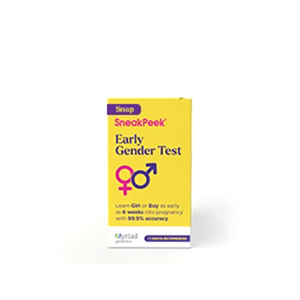Published on December 21st, 2021 and Updated on January 16th, 2024
Check out SneakPeek Gender Test to find out your baby’s gender as early as 6 weeks at over 99% accuracy1!
Too much sleep? For new parents, there’s no such thing. But what about babies? If your little one is stacking up those afternoon naps, you might wonder—can baby sleep too much?
In some cases, excessive sleep may be a sign of a sick or under-nourished baby, but more often than not, the fact that your little one is sleeping most of the day away means that his body and mind are hard at work growing and developing.
Luckily, when it comes to understanding your baby’s unique sleep behavior, SneakPeek can help you rest easy. From naps to nocturnal cycles, our guide below covers all things you need to know about newborn sleep requirements.
Why do babies sleep so much?
Daytime nap, afternoon nap, pre-dinner nap, bedtime—for someone who doesn’t really move, babies sure do sleep a ton. As it turns out, all that snoozing is necessary.
Consider sleep as the currency of healthy growth. At rest, infant bodies can devote their energy to critical physiological developments, such as:
- Brain development – For a strong mind, you need solid sleep. According to the American Medical Association, a baby’s brain grows by 1% every day for the first few months. It makes sense why—your little one’s learning a ton every day, from understanding how to track items with his eyes by 3 months to learning how to grab those items with his tiny little hands by 6 months.
- Body growth – Human growth hormone (HGH) is a hormone released during sleep that stimulates growth and cell reproduction in children and adolescents. If it feels like your baby grew two inches after a night’s rest, you can thank HGH. However, because HGH is released during sleep, a lack of sleep can impact your child’s growth.Studies even show that a lack of sleep correlates with lower HGH levels.
- Immune system response – Sleep in both adults and children promotes the production of cytokines—the white blood cells that fight off germs, viruses, and infection. If your baby isn’t getting the sleep he needs, his immune system can’t function as effectively.
- Mental and emotional acuity – Studies have found that just an extra 27 minutes of sleep a night improved children’s attention span and emotional regulation.
How much sleep should my baby be getting?
16 hours? 17 hours?? 18 hours??? Don’t let the third nap freak you out. To keep up with all their physiological developments, babies need way more sleep than adults.
On average, newborn babies sleep anywhere from 13 to 18 hours a day. In fact, most children spend more time asleep than awake until they’re about two years old. Over time, those sleeping hours will gradually decrease and transfer fully to nighttime rest.
To track your baby’s sleep pattern, take a look at average infant sleep hours:
- 0 to 4 weeks – 16 hours total (8 to 9 nighttime, 8 daytime)
- 1 to 2 months – 15.5 hours total (8 to 9 nighttime, 7 daytime)
- 3 to 5 months – 15 hours (9 to 10 nighttime, 4-5 daytime)
- 6 to 8 months – 14 hours (10 nighttime, 4 daytime)
- 9 to 12 months – 15 hours (11 nighttime, 3 daytime)
- 1 to 1.5 years – 14 hours (11 nighttime, 3 daytime)
- 1.5 years to 2 years – 13.5 hours (11 nighttime, 2.5 daytime)
If your little snoozer falls a bit outside these ranges, don’t worry. Every child has different needs, and that includes their ideal sleep duration—the total amount of sleep they need to function optimally.
Does my baby sleep too much?
Occasionally, a baby’s heavy sleep can go from typical to troublesome. To better understand the difference between a lot of sleep and too much sleep, take a look at the following signs of oversleeping:
- Few nighttime wake-ups – For the first few weeks, infants should wake up about every 2 to 4 hours for feedings. If your newborn constantly sleeps through feedings, she may be oversleeping.
- Low weight – If you have a heavy sleeper who misses out on crucial feedings, you may start to notice low weight.
- Erratic behavior – If your newborn baby consistently shows signs of irritation, excessive clinginess, or drowsiness, it could be due to suboptimal sleep habits.
If you notice any of these signs, it may be an indication that malnutrition, infection, or illness are causing your baby to oversleep. In these cases, it’s best to schedule an appointment with your pediatrician, who can properly examine and diagnose your little one.
In the first 0-4 weeks, sleeping through feedings are a sign of a potentially bigger problem. Breastfed babies shouldn’t go longer than about 3 hours without feeding and a bottle fed baby could go up to 4 hours. A risk in the first month of life is jaundice (yellowing of the skin) and one of the symptoms of high bilirubin levels in an infant is oversleeping or sleeping through feedings/dificulty getting them to nurse or eat. It’s important that you discuss this with your provider if you notice oversleeping in the first month especially.
Baby Sleep Habits: What’s Normal?
While sleeping a lot (but not too much) is necessary and normal for growing babies, there may be aspects of your newborn’s sleep schedule that you’d consider abnormal.
Waking up every 3 hours? Only sleeping when the sun’s up? Conking out immediately after eating (okay, okay—we get that one).
The truth is, for babies, “normal sleep” covers a wide range of behaviors due to your baby’s unique sleep cycle and lack of circadian rhythm.
Infant Circadian Rhythms
As it turns out, the habit of sleep as we know it is not so easy-peasy. Humans aren’t born naturally knowing to sleep at night and wake up in the morning. Standard active sleep and wake time are learned habits.
During infancy, our bodies develop a circadian rhythm—the 24-hour internal clock that tells us when to wake and when to sleep. Not all people have the same circadian rhythms, but all circadian rhythms are influenced by the same factors:
- Light exposure – Melatonin, the sleep hormone, is produced by the brain in response to darkness. When we’re exposed to light, the brain stops producing melatonin and starts producing cortisol, the awake hormone.
- Eating habits – Eating and digesting throughout the day helps keep us awake. In fact, when we eat, a hormone called insulin is released to absorb the glucose from our food. Research has found that this release of insulin impacts our circadian rhythms. As your little one’s nighttime feedings decrease, his circadian rhythm will strengthen and encourage him to snooze throughout the night.
When your baby arrives, he has zero circadian rhythm. In fact, because he’s been living in the total darkness of mom’s womb, his brain doesn’t associate darkness with sleep. Instead, babies in the womb typically follow the circadian rhythms of their mothers, as mom’s sleep and wake hormones travel through the placenta and impact baby’s sleep cycle. When baby is born, this placenta connection is broken, so he’s left to develop own circadian rhythm.
The Journal of Clinical Sleep Medicine states that newborns don’t steadily produce their circadian hormones (i.e. melatonin and cortisol) until 8 weeks. So, your baby won’t really understand the difference between day and night until then—it’s all just potential snooze time.
Infant Sleep Cycles
Why do babies wake so often during sleep? Aside from needing to eat frequently, babies also naturally have shorter sleep cycles than adults. Sleep cycles refer to repeated brain wave patterns during sleep, rotating through rapid eye movement (REM) and non-rapid eye movement (NREM) stages.
Here’s the typical sleep cycle of an adult:
- Dozing Off (NREM-N1) – The transitional “falling asleep” stage.
- Light Sleep (NREM-N2) – Defined by lowered body temperature and heart rate.
- Deep Sleep (NREM-N3) – Characterized by slowed brain activity.
- Deeper Sleep (NREM-N4) – When the body repairs itself, and the sleeper becomes harder to arouse.
- REM Sleep – A time of increased brain activity (i.e. dreaming) and memory formation.
Most adults experience this 4 to 6 times during the night, with each cycle lasting about 1.5 to 2 hours. However, babies rely on shorter 1-hour sleep cycles, comprised of only:
- Deep Sleep (NREM) – When baby’s body grows and develops.
- REM Sleep – When baby’s brain consolidates memories and information from the day.
The result of baby’s abbreviated sleep cycle? Frequent nighttime wake-ups and way more naps across the day.
How to Help Develop Healthy Sleep Habits
Your sleepy baby may not come with a circadian rhythm, but that doesn’t mean you can’t help her develop one. In fact, with a little patience and the following tips, you can establish a healthy sleep schedule faster.
Develop a Bedtime Routine
Researchers at the Family Resiliency Center found that bedtime routines during early infancy significantly improve sleep later in childhood. Start setting the stage for better sleep by developing a consistent bedtime routine (and sticking to it). This can include:
- Reading a book
- Giving baby a warm bath
- Rocking baby
- Listening to relaxing music
Your baby will learn to understand this routine and know when it is time to sleep as well as have an easier time drifting off into dreamland.
Establish a Sleep-Friendly Environment
Whether 9 months or 900 months, nobody likes an uncomfortable sleeping situation. Try introducing these soothing elements into your baby’s sleep environment to promote a longer, deeper snooze:
- A swaddling blanket – A swaddling blanket recreates the warmth and coziness your baby experienced in mom’s womb. Keep in mind; you should only swaddle your baby until he can roll over on his own (around the 2-month mark) to reduce the risk of suffocation. If your sleeping baby rolls over while swaddled, he won’t have the use of his arms to help lift his head away from the crib mattress.
- The right temperature – A slightly cooler room temperature (between 68 to 72 degrees Fahrenheit) is the best temperature for baby sleep.
- Noise mufflers – One little snap, crackle, or pop, and it’s game over. Noise-canceling tools, like under-door rubber mats and white noise machines, can hush these annoyances and ensure a sound (or rather, soundless) sleep for your little one.
- Light blockers – Help develop that circadian rhythm by using thick shades or blackout curtains on your nursery windows. By doing this, your baby’s brain will learn to associate darkness with sleep more quickly.
- Soft bedding – Itchy sheets? No, thank you. Choose quality fabric, like organic cotton, to give your little one the soft and breathable cloud he deserves.
A baby’s sleep habits, although unique to each individual, can be shaped through developing consistent bedtime routines and establishing a sleep-friendly environment. Although the question “can a baby sleep too much?” has no simple answer, understanding normal sleep requirements, identifying signs of oversleeping, and aiding your baby’s development of circadian rhythm, can ensure your little one gets the appropriate amount of rest they need for healthy growth and development.
If you want to learn more about baby sleep and have questions like, “when can baby sleep with a pillow” or “when can baby sleep with a pacifier”, or need advice on the best sleeping position for a baby with a stuffy nose, read our linked blogs.
This post has been reviewed for accuracy by the following medical professional:
Dr. Heather Soper, Certified Nurse Midwife
Dr. Heather Soper brings over 15 years of experience in women's health and obstetrics to her role as the owner of The Genesis Resort for Birth. Complementing her clinical practice, she serves as an Assistant Professor of Nursing at James Madison University, where she educates nursing students with a focus on compassionate, patient-centered care. Her advanced training and dedication to midwifery are evident in her contribution to both academia and the wellness of expectant mothers
Sources:
- Enfomil. The Importance of Sleep in Child Development. https://www.enfamil.com/articles/importance-of-sleep-child-development/
- Illinois News Bureau. Consistent bedtime routines in infancy improve children’s sleep habits through age 2. https://news.illinois.edu/view/6367/1153380885
- Infant Behavior and Development. Sleep disruption and motor development: Does pulling-to-stand impacts sleep–wake regulation? https://www.sciencedirect.com/science/article/abs/pii/S0163638315000612
- JAMA Neurology. Structural Growth Trajectories and Rates of Change in the First 3 Months of Infant Brain Development. https://jamanetwork.com/journals/jamaneurology/fullarticle/1893442
- Journal of Clinical Sleep Medicine. PERSPECTIVE: The Long-Term Effects of Light Exposure on Establishment of Newborn Circadian Rhythm. https://www.ncbi.nlm.nih.gov/pmc/articles/PMC6175794/
- NIH. Circadian Rhythms. https://www.nigms.nih.gov/education/fact-sheets/Pages/circadian-rhythms.aspx
- Parents Magazine. The 7 Reasons Your Kid Needs Sleep. https://www.parents.com/health/healthy-happy-kids/the-7-reasons-your-kid-needs-sleep/
- Parents Magazine. Is It Possible for Newborns to Sleep Too Much? https://www.parents.com/baby/sleep/is-it-possible-for-newborns-to-sleep-too-much/
- Sleep Advisor. 7 Baby Sleep Facts Every Parent Should Know. https://www.sleepadvisor.org/baby-sleep-facts-for-parents/
- Sleep Foundation. Stages of Sleep. https://www.sleepfoundation.org/how-sleep-works/stages-of-sleep
- Spanish Journal of Psychology. The Temporal Relation between Regression and Transition Periods in Early Infancy. https://www.semanticscholar.org/paper/The-Temporal-Relation-between-Regression-and-in-Sadurn%C3%AD-Burriel/558bbab662e91ad00496a192579eea7566063969
- Stanford Children’s Health. Infant Sleep. https://www.stanfordchildrens.org/en/topic/default?id=infant-sleep-90-P02237
- Science Daily. How eating feeds into the body clock. https://www.sciencedaily.com/releases/2019/04/190425143607.htm

Shop Our Products
SneakPeek aims to provide the most accurate and up-to-date information to help our readers make informed decisions regarding their health before, during, and after pregnancy. This article was written based upon trusted scientific research studies and/or articles. Credible information sources for this article are cited and hyperlinked.






